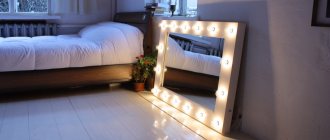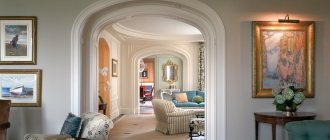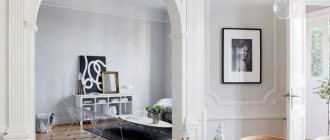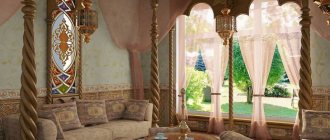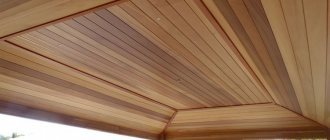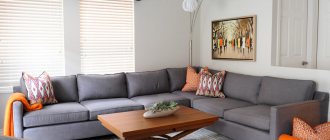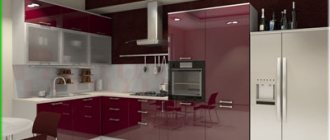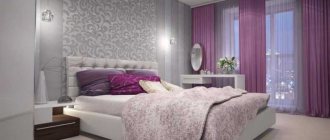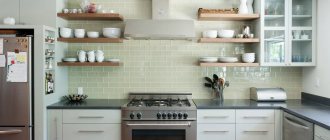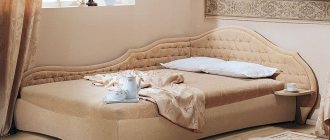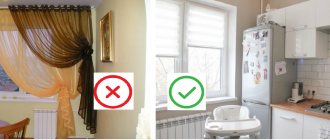Home » Rooms » Kitchen and dining room
DesignKitchen and dining roomInterior items
Alyona
9387 Views
Mirror in the kitchen
A kitchen mirror is a useful and necessary thing, but not always. The main purpose of a mirror surface is to expand the room visually, make it light and at least a little spacious. In a kitchen that is already large, it is needed only as an accent, and only if the designer has a desire to use it. Which material is better to choose? Which location would be most suitable? Everything is discussed in detail later in the article.
Is it possible to use a mirror in the kitchen?
From a Feng Shui point of view, hanging mirrors in the kitchen is not only possible, but also necessary! Their surface reflects positive energy, multiplying it.
According to Feng Shui, such a mirror will bring you good luck.
Important! Don't forget about safety precautions. You will need to purchase special heat-resistant glass, especially if you plan to hang it directly above the stove. There will be many such mirrors, but the costs are justified - an ordinary one can simply break due to temperature changes.
In addition, it is important to understand that all stains and the slightest droplets of water or grease will be visible on the mirror, so you will have to wash it often.
If glass seems difficult to maintain, replace it with reflective metal.
However, the use of mirrors is justified: in a small kitchen they make the room visually larger. In addition, mirrors give the room a special charm, making it sophisticated and unusual. The main thing is to find a suitable mirror and place it correctly.
Much depends on the design and location of the mirror. Also think about what it represents.
Dimensions
The smaller the room, the larger the mirror. The lack of free space in a Khrushchev building can be easily optically hidden with the help of a reflective wall. A spectacular accent can completely cover the surface, occupying an area from floor to ceiling. Narrow parts are used for zoning.
Small kitchen design Source msk.rucountry.ru
In a Stalinist apartment, studio or kitchen in a country cottage, small mirrors on a shelf or ceiling, in the edges of furniture or in the form of panels are enough. The elements do not optically correct the room, but in combination with lighting they create the desired mood. Colored options are often used, bringing the necessary warmth to the design.
Medium-sized mirrors in the kitchen are used to cover the work area and apron. In a dark room without windows, structures half human height will help increase lighting. The surfaces reflect incoming rays and create a play of light in the room.
How to beat a mirror in the kitchen
Much in the perception of a room depends on where to hang the mirror in the kitchen. Don't think that it can only be used in the traditional way - glass in a frame. There are many interesting ways to use mirrors. Let's look at the most successful ones.
There are many non-standard options for using mirrors in the kitchen.
Mirrors are often used to expand the space - this technique looks especially impressive in a small kitchen in a Khrushchev-era building or other small-sized apartments. In this case, the surface reflects the opposite wall, visually making the room twice as wide.
A neat mirror can visually enlarge the kitchen.
On the other hand, it is precisely because of this property that in spacious kitchens you should not hang large mirrors on the entire wall - this can easily upset the balance of perception and make the room too bulky and uncomfortable.
Mosaics and mirror panels look very unusual. It is important to choose the right shape and decide where to hang such a mirror - a refracted reflection may not look very aesthetically pleasing, so it is better if a smooth wall is reflected on the surface of the structure.
The mosaic looks impressive, but it needs to be carefully thought out.
A thin strip of mirror on the apron, illuminated from above by an LED strip or spotlights, will make cooking on the countertop much more comfortable. This way, the countertop will be well lit and you will be able to see your food from all angles without having to turn it.
Illuminated mirrors are a fashion gimmick.
True, there is also a minus - you will have to clean the mirror after almost every firing, since all the splashes and marks will be visible on it. On the other hand, with modern detergents this is unlikely to be a problem for you.
A very bold and unusual technique is to use a mirror instead of an apron. Most often it is used for kitchen sets with narrow countertops, so they visually become wider.
A mirror is popular instead of an apron.
Please note that the workspace will now require a very careful approach. You will not only have to regularly clean the apron, but also keep the tabletop clean - crumbs and stripes on the set are unlikely to add attractiveness to the reflection.
Also try to order the strongest possible mirror glass - the apron is often subject to mechanical stress, so you only risk breaking regular glass. This is fraught not only with the need to replace the apron, but also with injuries, even quite serious cuts.
Sometimes mirrors replace kitchen facades. In this case, strength also plays an important role. By the way, it is not necessary to cut the facades directly with mirror glazing. Using shiny metal surfaces, glossy shiny acrylic surfaces can give a lighting effect...
It is better to replace glass on facades with metal.
Try experimenting with materials. In addition, caring for pure mirror facades is quite complicated - it is quite possible to find a less capricious option that will look just as aesthetically pleasing, but benefits in terms of practicality.
In addition, it should be borne in mind that mirrored facades do not fit any style of kitchen design; for example, they are almost impossible to imagine in a classic interior.
In a classic style, mirrors look best as decoration.
Some design solutions involve hanging a mirror in the kitchen near the sink. This technique may look very elegant, but there are a number of nuances to consider:
- No matter how carefully you wash the dishes, drops of water will constantly fall on the mirror surface. This means that you will have to constantly clean the glass.
- It is very important to choose the right frame for the mirror. It should be a moisture- and steam-resistant material that does not deform after a couple of months.
- Pay attention to how tightly the edge of the frame fits against the glass. If there are gaps, moisture will get in and mold may develop over time. This is fraught not only with an unpleasant odor and untidy appearance - mold from such a source can easily spread throughout the kitchen.
- If a mirror is constantly exposed to steam, it will fade over time. You will need special cleaning products. If you are against using chemicals in the kitchen, you can replace them with a vinegar solution. But remember that you need to clean the surface regularly, only then will it shine.
The kitchen mirror above the stove should also be very resistant to heat and steam. Avoid using plastic frames - your choice is metal and wooden frames with special impregnation.
In this case, the glass must be especially strong.
In addition, you will need a special polish to prevent steam from forming on the glass, otherwise the mirror will fog up all the time.
Consider the angle of reflection of the mirror - it is better if the image in it is attractive. In this case, it’s a good idea to hang a special hanger above the stove and on it - nice copper or ceramic pots and kitchen utensils.
Important! Wherever you decide to hang a mirror in the kitchen, imagine what will be reflected in it. Sometimes a little aesthetic consideration can ruin the entire perception of even the most thoughtful kitchen in terms of design.
A mirror hanging on the front of the refrigerator can look very elegant. But here you need to think about the degree of accuracy of your family members. Constantly scrubbing prints off a reflective surface isn't much fun. If there are small children in the house, you should abandon this idea - it will take a lot of effort to keep the mirror in good condition.
Sometimes it is more rational to replace the mirror with reflective equipment.
In addition, it is very important to properly fasten the mirror to the refrigerator: if the fasteners are not strong enough, there is a risk that the glass will simply fall under its own weight. As an alternative, it is recommended to use plastic mirrors or mirror films. These options are much simpler, cheaper, and much easier to fix.
As you can see, there are many options for decorating a kitchen with mirrors in the work area. As for the dining area, you can also find very interesting techniques here.
Using a mirror on your dining table will make your kitchen feel more inviting.
For example, a mirror above the dining table can make the dining area appear larger and more comfortable. We recommend lighting the mirror with small lampshades in the corners to create a cozy and familiar dining area.
For the same purpose, mirrors are hung in the kitchen above the sofa. However, it is important to ensure that the latter has a fairly wide back: touching the back of the head with a mirror is not only unpleasant, but also dangerous.
There are more ambitious ways to add mirrors to your kitchen. For example, you can design a completely mirrored ceiling. However, keep in mind that this trick is only suitable for people who are used to keeping the kitchen in perfect order, otherwise you will have to immediately learn how to clean up the slightest mess. Any defect will immediately attract double attention. In addition, the ceiling itself should be cleaned frequently, especially above the stove and sink where steam loss is most common.
A broad but complex solution.
As for a mirror floor, we don't recommend it in the kitchen for the same cleaning reasons: you'll have to wash it after almost every meal. Therefore, such a coating can tire even the most careful housewife.
Wall decoration near the dining table: other ideas
Now let's move on to less trivial design methods. These types of finishes are much less common than those discussed above.
Note board
It is a wall panel that is used to attach various notes, reminders, postcards, photographs, etc. to it.
The necessary papers will be in sight of your family, so you won’t be able to forget something important. You should not use the memorial plaque only for practical purposes, because this is not an office, but a dining room in the house. You should definitely put something fun, cute, and romantic in your notebook.
Letters
Just recently, voluminous “book decoration” was at the height of fashion. Today, the cards have lost their positions, but are still relevant. In the dining room, letters can be used to place the initials of the owners, the names of dishes, wishes for a bon appetit, calls for food, or some witty aphorism related to food.
Calendar
Hanging a hanging calendar above the table was a custom in our Soviet past. This method is used in the West today. A practical and convenient solution is a calendar with the ability to take notes. While eating, you can make plans, set dates, and dream about something.
Giant cutlery
Yes, it's retro terry, but why not? This themed decor fits perfectly into the dining room setting.
They hang both the devices themselves and panels with their silhouettes (carved or drawn).
Decorative panels
Often these things are made by hand. A kitchen panel is a medium-sized panel decorated with, for example, coffee beans, cereals, pasta, dried plants, etc.
What to look for when choosing a mirror for the kitchen?
For the kitchen, you should buy only the highest quality and durable products that are not afraid of heat, humidity and detergents. For example, cheap mirrors and polystyrene foam films quickly deteriorate and get scratched. Classic thin coatings based on glass are considered too fragile; it is even better to abandon them in favor of triplex - multilayer materials based on polymers.
If the mirror will be located far from the work area, for example at the top of the room, it can be acrylic. Such products are easy to install and maintain, lightweight and inexpensive.
Mirrorplex plexiglass 2 mm
Mirror acrylic is used to make tiles (tiles in the shape of a square, circle, hexagon), mosaics (small elements 2x2 cm or 3x3 cm), and sheet metal panels. To decorate large areas, you should choose wide-format material of sufficient thickness (6-7 mm).
Important! It is not recommended to purchase frameless mirrors for the kitchen - they will be vulnerable to chips and cracks.
Models with shiny edges, beveled edges and beveled corners look more beautiful. The design of mirrors can also be varied:
- Satin finish. Chemical etching creates a matte effect on the glass.
- Color. Instead of the traditional one, you can choose a colored product, the base of which is painted in the selected shade.
- With aging effect. Typically, such models are used in retro interiors. Their surface is treated with special substances that make it opaque, with cracks and defects.
- With drawings. Using sandblasting, various designs, ornaments, and designs are applied to mirrors. Frosty and floral images are considered quite popular decorations.
- Amalgam decoration. The glass surface is partially destroyed using special machines, and colored pigments are applied. The product becomes, so to speak, velvety in appearance, with visible mirror motifs.
Mirror tiles with bevel
How to properly place a mirror in the kitchen - advice from Feng Shui experts
Those who want to bring harmony to the kitchen space need to:
- The mirror reflected the dining table. It is believed that this will attract material well-being and family well-being. This pose is also useful for those who are just dreaming of a wedding: you can always check the amount of food eaten at one time. Looking in the mirror, you need to experience only positive emotions, then there will be even more of them.
- The entrance to the kitchen was reflected.
- If dirty trash cans or dishes are not visible in the mirror, this will increase the negative energy coming from these items.
It is always worth remembering to appreciate only the positive aspects and carefully monitor what you see in the reflection.
Gastronomic theme
Paintings and posters that whet the appetite, decorative plates are the best way to hint at the purpose of the site. And where else can you see them if not in the dining room.
- Painting, poster. Small paintings are best placed in groups. It is not necessary for the plot to be clearly gastronomic. You can use images of people eating, "Girl with a Peach" or something similar.
- Decorative plates. Many people collect such signs while traveling around the world. They belong on the wall next to the dining table. They will not only decorate and highlight the area, but will also help brighten up awkward pauses during conversations. Just look at them and remember interesting travel stories. You can choose dishes for any cooking style.
- Huge devices. An unusual solution in the spirit of a “Soviet canteen”. But many people like this design. Why not?
- Textile. These handmade items radiate warmth. A tablecloth for the kitchen is made from coffee beans, wine corks, herbarium, spices, and candied fruits. They are used to make pictures or an interesting composition is assembled under glass.
What material is better for kitchen mirror design?
Mirror designs can be made from glass, acrylic and polystyrene. It is better not to use the latter in the kitchen, as it is afraid of moisture and is not resistant to mechanical damage. Therefore, let’s take a closer look at the other two options.
Acrylic. These mirrors are highly durable and are considered the safest. Additional benefits include ease of installation, transport and cutting. Disadvantages include high cost and susceptibility to scratches.
Glass. Such patterns are heavier than acrylic and are used for finishing backsplashes and walls.
Based on such designs, the following elements are produced:
- mosaic slab - used for cladding walls, aprons and some elements. This type of finishing has many advantages: the invisibility of streaks and halos, the possibility of a uniform base, the possibility of local repairs and an effective aesthetic component. Disadvantages include the high price and the need for periodic cleaning of the seams;
- sheet metal panels - usually used for finishing walls, aprons, and furniture facades. Their thickness ranges from 4-6 mm;
- tiles - can be of various shapes (squares, triangles, hexagons, etc.) and sizes.
Design options for mirror surfaces in kitchen interiors
The appearance of the mirror surface is very different. In addition to the traditional shiny silver canvas, you can choose from the following varieties:
- Colored mirror: Gold, graphite, champagne colors, as well as shades of blue, green, red, pink and purple are obtained thanks to the colored base glass in the mass.
- Satin (satin) - a mirror made of satin with chemical etching. The entire canvas can be satin, or simply designer, as shown in the photo below. The satin finish is similar in appearance to sandblasting, but appears more polished and smooth.
Satin in a kitchen apron
- Aged: the effect of a matte surface with peeled amalgam is also achieved by chemical etching or direct printing applied under the amalgam layer. Antique mirrors are best suited to a classic kitchen interior.
- With a pattern underneath the amalgam, the mirror can have any design or motif you want. It is applied to the film using direct UV printing, then glued to glass and covered with amalgam.
- With sandblasting design - the sandblasting method can be applied to the outside of the mirror (to get a frosted effect) or on the reverse side, that is, on the amalgam (to get the effect of a design inside the mirror). An important nuance: a sandblasted mirror must be framed. Also note that it is not suitable for covering an apron, as it requires careful handling.
Chalk board
Do you like to draw or leave messages for your loved ones, or maybe you have children who don't mind drawing on the walls? Then you might like chalkboard. Such decoration is rare, but it certainly cannot leave anyone indifferent.
The table will fit best into Scandinavian and loft style.
The rules for choosing sizes are the same as with a pattern: the wider the wall, the larger the board can be. And if the prepared options do not suit you, you can do it yourself. It's easy to do, all you need is special chalk paint. However, you can get by with the usual one; just mix it with some granular substance to get the necessary rough surface.
The countertop is easy to care for: wipe it with a damp cloth. But be careful, it is easy to scratch. To protect the delicate layer, use only soft materials for cleaning.
Examples of kitchen mirror designs
Original design ideas using mirrors.
Mirror above the stove
This arrangement of the mirror surface allows you to visually increase the height of the ceiling and gives the kitchen space an airiness and unusual look. The mirror will fit perfectly into any room and will become the highlight of the entire interior. The main thing is not to place it too close to the hob, this will help avoid splashes that will spoil the appearance of the product and make the interior untidy.
Mirror over the sink
When placing reflective surfaces in this area, the following rules must be observed:
- The bottom edge should be at least 30 cm from the sink. This is due to the fact that this distance allows you to protect it from splashes and drops.
- Height should correspond to the height of the tallest family member. This will allow all family members to use the mirror comfortably. But it is worth remembering that the top should not be higher than the door.
- You should respect the proportions of the room, and install a mirror according to them; you can focus on the width of the sink.
Do not use a mirror covering that is too bulky or, conversely, very small, as it will look out of place.
Mirror apron
This type of kitchen decoration causes a lot of controversy and controversy. On the one hand, it decorates the room, making it lighter and more spacious, on the other hand, constant splashes and drops of oil will require constant cleaning.
Although it all depends on the material from which the apron is made - it can be monolithic reflective panels, a panel of several fragments or mosaic mirror tiles. The first option will unite the space and visually expand it, and the latter will create a whimsical play of light.
Reflective surfaces can be painted, distressed or beautifully embossed.
Mirror ceiling
The ceilings are decorated with mirror tiles or large panels. They usually fill up to 10-50% of the space above the head or form small mirrored islands next to lighting fixtures. This technique will add elegance to the atmosphere and make the room rich and luxurious.
Mirror in the dining area
Mirrors in the kitchen above the dining table, as seen in the photo, are used quite often. In this case, you can choose several options: a large panel the size of a person or a small figured mirror, complemented by an elegant frame. This option will fit perfectly into a classic or minimalist style.
The mirror should reflect the table or lamps. In the first case, it will be possible to lengthen the table, in the second - to make the kitchen more elegant.
An excellent option would be a mirror in the dining room
Mirror mosaic
The artistic elements of the mirror have a subtle reflective effect, giving the kitchen space a special airiness and at the same time exclusivity.
Panel
A decorative panel fills the room with a lot of reflections, creating the illusion of volume and adding magic and charm to the atmosphere.
The photo shows a mirror panel on the wall above the dining area in a high-tech kitchen interior.
Decorated mirrors
Thanks to the variety of original and spectacular frames, it is possible not only to make the mirror charming, chic and picturesque, but also to easily enliven the room, creating the desired atmosphere.
Large wall mirror in the kitchen
In some kitchens, an oddly shaped wall or wall does not fit with any type of furniture. You may consider this space negative because you don't know what to do with it. A decorative wall mirror can add a sense of functionality to the wall and also visually expand the room, which can be an added bonus. It can also help bounce light from another part of the kitchen to illuminate a wall or area that hasn't received much attention.
Mirrors do not have to be strictly attached to the wall. You can use mirrors in other forms, such as for lighting. Hang mirrored pendant lights on your kitchen counter or island to add elegance. A single panoramic mirror behind the sink can give the impression that there is a window, which is a great illusion for kitchens without windows or natural light.
Backlit
The ideal symphony of light emanating from the lighting allows you to organically emphasize the shape of the mirror product and make it an exquisite interior decoration that will not go unnoticed.
Mirror skins for the kitchen
To make kitchen furniture, you can use skins that are long panels (up to 3 meters). A kitchen with this finish looks very stylish; in the photo you can see examples of kitchen aprons decorated with glass panels.
Kitchen mirror covers do not require special care; in general, they are very practical. Such panels can visually increase the area and volume of the room, and also allow you to emphasize the individuality and style of your kitchen.
Mirror overlays for the kitchen are very practical
Currently, designers have begun to use mirror leather in the interior. These elongated panels are placed in different rooms and areas: kitchen aprons, bathrooms, wardrobe facades, restaurants and cafes. Skinali can fill the entire wall or part of it, and can also be used as a decorative insert on furniture.
Beveled panels catch and reflect sunlight that comes through the window, so you can flood the room with extra light. Mirror panels visually enlarge the space, change the geometry of the room and hide some of its shortcomings, which is why many owners of small kitchens use this decoration technique.
Mirror panels with beveled edges
New furniture ideas, interesting designs of mirror surfaces and their edges, games with shapes and shades allow you to create incredible solutions for kitchens of any size. A little imagination and creativity will allow you to create a kitchen with a luxurious and attractive interior.
A mirrored mosaic panel always looks very impressive; such a composition can divide the kitchen into zones and smooth out the transition between different finishes. Mirrors combine well with many materials without creating an unbalanced effect.
Mirror mosaic always looks very impressive
Designers recommend using mirror skins as the main element of kitchen decor. They can be additionally decorated with a pattern or stained glass inserts. The panels can vary in shape; depending on the size of the room and the wishes of its owner, you can use mirror panels in the shape of a diamond, square or rectangle.
Using thin mirror skins in the kitchen, a decorative bridge is created between different surfaces on a smooth wall; this technique is used if it is necessary to make a transition from one color or finishing material to another.
Full wall mirror
Another approach is to choose a huge mirror that fits almost the entire wall.
In this case, it can play not only the role of expanding the space, but also the role of the main decorative element of the kitchen.
Undoubtedly, a mirror panel of this size will attract all the attention, so initially you need to take care of the ideal frame for it.
We think it goes without saying that any mirror, first of all, creates an excellent visual effect by increasing the kitchen area.
But, as you can see above, in some cases it also plays an interesting decorative role.
Kinds
Popular types of mirror models.
Built-in
There are two types of built-in products:
- In furniture. Reflective fabrics built into various furniture pieces, such as wall cabinets, shelves, refrigerator doors or sideboards, can create an unusual optical effect in the room and add complexity and versatility to the interior.
- Into the wall. Models mounted into walls or niches allow you to save space, add the missing volume, additional light and simply create a fascinating design.
Mirrors, thanks to the light play of light, significantly expand the boundaries of the room and deprive it of the feeling of crampedness and congestion.
Floor-standing
Elegant floor mirrors or psiche models have a particularly expensive and presentable look. Such convenient mirror specimens, thanks to their well-thought-out design, make it easy to change and set the desired angle of inclination.
Wall mounted
The simplest, most familiar and classic way of placement. When using wall-mounted products in a kitchen work area, it is advisable to place them at eye level or higher to avoid unnecessary contamination.
The photo shows a small rectangular wall mirror in the interior of a modern kitchen.
Designer design of mirrors in the kitchen
To add zest to the interior or create a light and airy space, mirror surfaces are used. And if you use various design techniques, for example, a pattern under amalgam or applying a pattern using sandblasting techniques, you can give the kitchen a new look. Or create an unusual art object that will become a style accent and attract attention.
Color design
This type of mirror panels helps create harmony in the room and add a touch of magic. Depending on the chosen shade, you can give the kitchen space a certain atmosphere, for example, gold or bronze will add solar energy, red will invigorate and lift your spirits, and blue or olive will help you relax.
The following technologies are used to produce mirrors of different shades:
- A layer of amalgam is applied to the surface of the glass, into which a coloring pigment is added.
- You can also tint the glass with a silver spray, then prime it and cover it with several layers of protective varnish.
To ensure the strength of the finished panel, the back side is treated with a metal spray and covered with a special film. Mirrors have a number of advantages: their surface does not fade, lasts a long time and is not afraid of extreme temperatures.
Satin
This is a special type of mirror surface with a matte layer. It can be of two options: plain or with images/motifs. The technology to create this unusual texture uses a chemical engraving method that allows you to get a perfectly clear image.
Mirrors made using this technology help create an exclusive and non-standard interior. They are usually used in the design of kitchen facades, aprons or door panels. Commonly used motifs include mosaic, labyrinth or square motifs.
Sandblasting pattern
This technology involves treating the glass surface with a jet of compressed air. The result is a dull, flat or raised image. The work takes place in several stages:
- First, a drawing is selected.
- A stencil is made on its basis.
- The glass surface is prepared.
- The model is attached to it.
- This is followed by applying the model using a direct stream of air containing an abrasive.
- Finally, a special varnish-based composition is applied (necessary to protect the image).
The application technique can be traditional, opaque or more complex: in-depth, relief, colored or artistic.
Aged mirror effect
Vintage-style reflective surfaces are a trend in interior design. A similar effect can be achieved using the following technology:
- Remove the protective layer. This is done using nail polish remover, so rinse off any residue with plenty of water.
- Remove part of the amalgam. To control this process, you need to bring the mirror to the window.
- Paint over the resulting gaps with acrylic paint. The colored layer can be applied with a special sponge. The choice of shade depends on personal preference, usually terracotta, gold or bronze tones are used.
- Sand part of the surface. This is necessary to enhance the aging effect.
You can also add antiquity to the mirror by sprinkling the amalgam with hydrochloric acid.
Rules for installing mirrors in the kitchen
Mirror structures must be fixed on flat surfaces. Proper wall preparation is of particular importance, especially if you are installing a sheet metal mirror splashback or a full-wall mirror.
Openwork moldings and mirrors, illuminated by soft light, turn the kitchen into a work of art
Installation of the material can be done in several ways:
- fastening and drilling elements;
- liquid glue or nails;
- hooks
sixteen
On a note! It is best to use adhesive fasteners, although other options are often used in practice.
